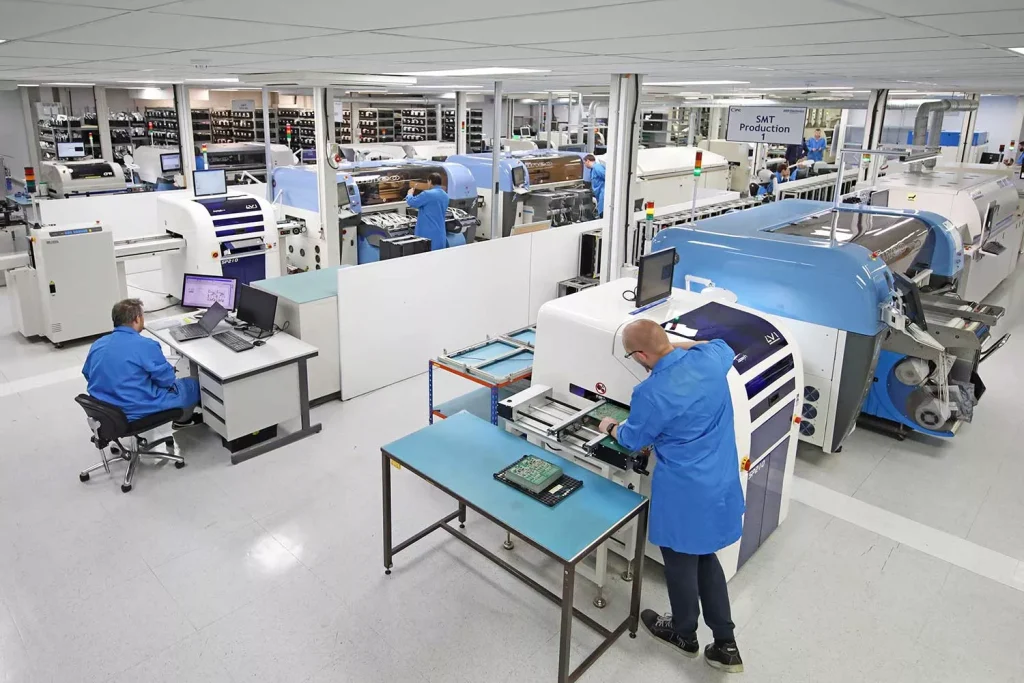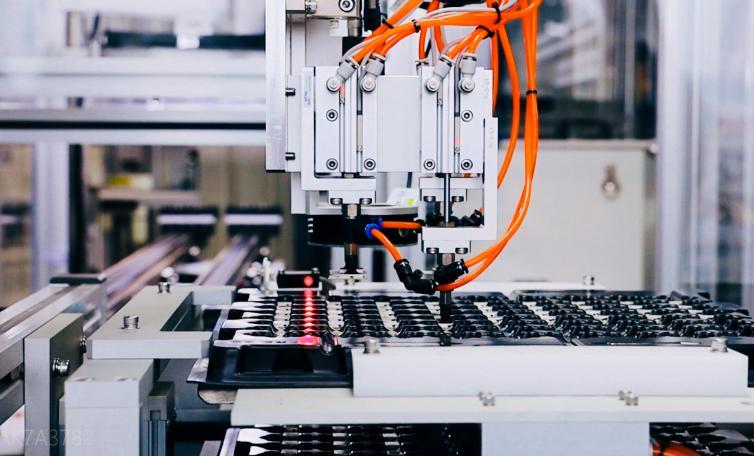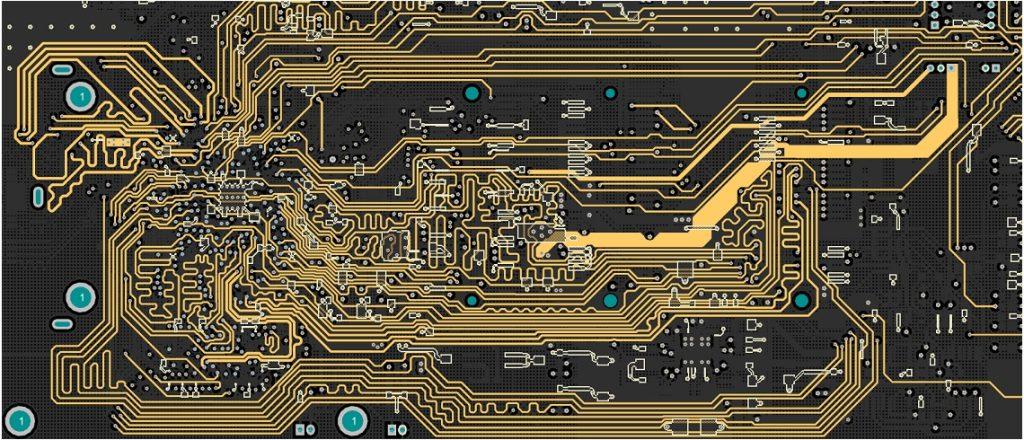- What is the relationship between PCB, PCBA, and SMT?
- SMT chip processing technology assembly method
- SMT PCB assembly and the basic process
- SMT placement processing using PCB requirements
- SMT assembly quality measurement criteria
- SMD on the circuit board assembly, what influence
- How to choose a quality set SMD processing factory?
- 3, look at the degree of professional fit
SMT is Surface Mount Technology, the most popular technology and process in the electronic assembly industry. It is a kind of surface assembly component without pins or short leads (referred to as SMC/SMD, Chinese called sheet components) mounted on the surface of the printed circuit board (Printed Circuit Board, PCB) or another substrate surface, through reflow soldering or dip soldering and other methods to weld the assembly of circuit assembly technology. So why choose PCB SMT assembly? This article takes you to understand PCB SMT assembly in detail.
What is the relationship between PCB, PCBA, and SMT?
Speaking of PCB, we are familiar with, PCB is also called printed circuit boards, printed circuit boards; hardware engineers inevitably have to play a few boards. But mention SMT and PCBA, but few people understand what is going on, and even often confuse these concepts, so what are the differences between PCB, PCBA, and SMT, and what are the links?
PCB: Chinese name for printed circuit board, also known as a printed circuit board (abbreviation of Printed Circuit Board), is used to support the carrier of electronic components and provide lines so that electronic components can form a complete circuit between.
SMT: SMT is surface assembly technology (abbreviation of Surface Mounted Technology), a popular process technology, through process to mount electronic components on the PCB board, also known as surface mount technology.
PCBA: refers to the raw material procurement, SMT placement, DIP plug-in, testing, and assembly of finished products and other one-stop service processing processes (abbreviation of Printed Circuit Board Assembly).
To sum up, “PCB is a board, SMT is a kind of technology, PCBA is a process / finished product” in an empty PCB board, SMT placement (or DIP plug-in), the finished product can be called PCBA, or the process can be called PCBA. when we open the electronic products, you can see the circuit board is soldered with components, this time the circuit board is the PCB after PCBA processing.
SMT chip processing technology assembly method
In the traditional THT circuit board, the components and solder joints are located on both sides of the board, while in the SMT printed circuit board, the solder joints and components are located on the same side. Therefore, in SMT printed circuit boards, through-holes are only used to connect the wires on both sides of the board. The number of holes is much less, and the diameter of the holes is much smaller, so you can greatly increase the assembly density of the circuit board to enhance it. SMT chip processing technology assembly methods are as follows.
1, SMT single-sided mixed assembly method
One is a single-sided mixed assembly, SMC / SMD, and through-hole inserted components (17HC) distributed on different sides of the PCB, but the welding surface is only a single side. This assembly method uses a single-sided PCB and waves soldering (currently usually dual-wave soldering) and has two specific assembly methods.
(1) first paste method. In an assembly method called the first paste method, the B side of the PCB (soldering surface) first pastes SMC/SMD and then inserts THC on the A-side.
(2) Post-paste method. Another assembly method, called post-paste, is to insert THC on the A side of the PCB first and then SMD on the B side.
2、SMT double-sided hybrid assembly method
The second type is a double-sided mixed assembly; SMC/SMD and T.HC can be mixed and distributed on the same side of the PCB; at the same time, SMC/SMD can also be distributed on both sides.PCB. Double-sided hybrid assembly using double-sided PCB, double wave soldering, or reflow soldering. In this type of assembly, there is also a difference between the first or second SMC/SMD, which is usually chosen reasonably according to the type of SMC/SMD and the size of the PCB, usually using the first-paste method more. Two assembly methods are commonly used in this type of assembly.
(1) SMC/SMD and ‘FHC same side method, SMC/SMD and THC on the same side.PCB.
(2) SMC/SMD and THC different side approach, where the surface assembly integrated chip (SMIC) and THC are placed on the A side of the PCB, while the SMC and small form factor transistor (SOT) is placed on the B side.
SMT PCB assembly and the basic process
SMT basic process components include screen printing (or dispensing), placement (curing), reflow soldering, cleaning, testing, rework
1、Silkscreen printing: Its role is to print the solder paste or patch adhesive leakage to the pads of the PCB in preparation for welding components. The equipment used is a screen printing machine (screen printer) located at the front of the SMT production line.
2、Dispensing: It is to drop glue to the fixed position of the PCB; its main role is to fix the components to the PCB board. The equipment used is dispensing machine located at the front end of the SMT production line or behind the testing equipment.
3、Placement: Its role is to accurately install the surface assembly components to the PCB’s fixed position. The mounter equipment is located in the SMT production line behind the screen printing machine.
4、Curing: Its role is to melt the SMD adhesive so that the surface assembly components and PCB board are firmly bonded. The equipment used for curing the oven is located in the SMT production line behind the mounting machine.
5, reflow soldering: its role is to melt the solder paste so that the surface assembly components and PCB board are firmly bonded together. The equipment used is a reflow oven located in the SMT production line behind the bonder.
6, cleaning: its role is to assemble the PCB board above the harmful welding residues such as flux removed. The equipment used for the cleaning machine, the location can not be fixed, can be online, or not online.
7, testing: its role is to assemble the PCB board for the quality of welding and assembly quality testing. The equipment used is a magnifying glass, microscope, online tester (ICT), flying probe tester, automatic optical inspection (AOI), X-RAY inspection system, functional tester, etc. According to the needs of detection, location can be configured in the production line’s appropriate place.
8, rework: its role is to detect the failure of the PCB board rework. The tools used are a soldering iron, a reworking workstation, etc. Configured in any position in the production line.
SMT placement processing using PCB requirements
In SMT placement processing, PCB substrates, before the start of processing, the PCB will be checked and tested, selected to meet the SMT production requirements of the PCB, and the unqualified returned to the PCB supplier; PCB-specific requirements can be referred to as IPC-a -610c international general electronic industry assembly standards, SMT placement processing of the basic requirements of the PCB are as follows.
1, PCB shall be flat and smooth
PCB generally requires flat and smooth, can not be warped, or in the solder paste printing and placement will produce great harm, such as the consequences of cracks.
2, thermal conductivity
In the reflow and wave soldering, there will be a preheat zone, usually to heat the PCB evenly and reach a certain temperature; the better the thermal conductivity of the PCB substrate, the less bad will be produced.
3, heat resistance
With the development of the SMT process and environmental requirements, the lead-free process has also been widely used but also caused by the rise in welding temperature, the heat resistance of the PCB higher requirements, a lead-free process in reflow soldering, the temperature should reach 217 ~ 245 ℃, the time lasts 30 ~ 65s, so the general PCB heat resistance to 260 degrees Celsius, and last 10s requirements.
4, the adhesion of copper foil
The bonding strength of copper foil should reach 1.5kg/cm. To prevent the PCB from falling off due to external forces.
5、Bending standards
PCB has certain bending standards, generally reaching 25kg/mm or more
6、Good electrical conductivity
PCB as a carrier of electronic components, to achieve the link between components, to rely on the PCB lines to conduct; PCB should not only have good electrical conductivity, and PCB lines broken can not directly patch up, or the performance of the whole product will cause a great impact.
7, can withstand the solvent washing
PCBs in production easily become dirty and often need cleaning of the board with water and other solvents. The PCB should be able to withstand solvent washing without producing bubbles and some other adverse reactions.
SMT assembly quality measurement criteria
SMT assembly quality is the abbreviation of SMT product assembly quality. It describes the SMT product assembly process and the results of the inherent characteristics involved in meeting the degree of requirements. It refers to the quality of assembly design, quality of raw assembly materials (components, PCBs, solder paste, and other assembly materials), quality of assembly process (process quality), quality of assembly solder joints (result quality), quality of assembly equipment (condition quality), quality of assembly inspection and assembly management (control quality) and other quality design, inspection, control, and management behavior and results in the assembly of electronic circuit products using SMT. The results. It is measured whether the assembled SMT product meets its specific design requirements. It involves SMT and its assembly design, assembly materials, assembly processes, assembly equipment, assembly systems, assembly environment, technicians, and other aspects.
The poor quality of SMT product assembly can be reflected by device failure, operation failure, and assembly failure in the three main types of failure. Among them, the device fault (Device Fault) mainly refers to the fault caused by the quality of components, such as components performance indicators beyond the error range, bad or failure, mislabeled model caused by misplacement placement, pin break missing, etc. Operation Fault (Operation Fault) refers to the product that can not work normally, but not the device failure and assembly failure caused by. Generally is due to the design of the problem caused, such as timing with the fault (Timing Fault), error accumulation fault, PCB circuit error fault, etc. Assembly Fault (Assembly Fault) is the fault caused by the problems in the assembly process, such as a solder bridge, even a short circuit, false solder break, wrong or omitted to paste of the device, and so on.
In production practice, the failure rate of the above three types of failure is roughly less than 8% for device failure and operation failure and more than 85% for assembly failure. In these three types of failures, device failures can be minimized by strengthening the quality of incoming materials. Operational failures have become secondary to the continuous improvement of circuit CAD technology and component manufacturing technology today. As the main source of failure in SMT products, Assembly failure is the core problem to be solved by SMT assembly quality control. Therefore, although in the SMT product assembly production process, all aspects of quality factors have an impact on the final results of the product, in the assembly design and assembly of raw material quality, assembly equipment, and testing equipment performance, and other aspects of the quality factors have a basic guarantee of the premise, the main link affecting the final results of the assembly quality is the assembly process quality link, the main manifestation of poor assembly quality is assembly Failure.
SMD on the circuit board assembly, what influence
Reflow ovens are often used for wave soldering when soldering surface mount components and may not accurately cover smaller, fine-pitch components. The reflow process provides enough time for the solder to reach all necessary areas and for temperature control. Many SMT packages require the use of an over-hole, which also means that internal board inspection is required, which is not particularly important for THT components. SMD can also be subject to solder bridging, where one side of a component comes off and needs to be reworked.
Another important factor influencing the choice of component technology is the type of design. For example, it is recommended to choose THT for high-power applications because these devices tend to be heavier and require stronger adhesion; THT is just right for the job. SMT components, on the other hand, are lighter and only attach to the board’s surface. This means they are likelier to shift in environments with vibration and constant motion. In these cases, it may be necessary to add support to ensure that the SMD is held in place to the maximum extent possible.
Even with these factors of PCB assembly in mind, SMT components are still very attractive for PCBA and electronics development due to the advantages of a smaller board and product sizes, more sophisticated design capabilities, and lower costs.
How to choose a quality set SMD processing factory?
Because the demand for electronic products has increased greatly, so now there are many SMT processing factories, with which there is a cooperation between the enterprise customers in the choice of the processing plant will also have difficulty in choosing, in response to this situation, the following about how to choose a quality SMT chip processing factory, I hope to help companies that want to understand the quality manufacturer.
1, choose the right, then choose the size of the size is more important
Many people misunderstand some SMD factories that as long as the size is large, it must be good. The scale size also has some reference value but is not absolute; some large-scale PCB manufacturers are not necessarily suitable for all customers. First, look at the volume of orders; some customers need to do the amount is not very large, so it is less necessary to find those large-scale manufacturers to produce and process. The size of the manufacturers, the cost is relatively large, the order volume is large, and the time required is longer. It is better to directly choose the processing plant suitable for the production of their own business. Although some aspects are not as good as large factories, smaller processing plants also have their own advantages: more targeted enterprises specializing in a certain industry or a certain product customization.
2, look at the SMT processing plant equipment
SMT SMD processing factory is generally divided into high-end precision, the use of more advanced equipment up to high efficiency, and high-quality production. There is another relatively cheap kind, the use of relatively inexpensive equipment; the yield is not as high as the first kind but also able to produce some products in small quantities. The former is a relatively large scale of large factories, such as Foxconn and the like; the latter is mostly relatively small-scale factories or workshops, the orders received are relatively small, equipment is mostly older, there is no professional management, quality assurance is also difficult to say, so the price is generally lower. If you are required to process more authentic products with higher added value is recommended to choose the first type of more quality assurance.
3, look at the degree of professional fit
Pcba board is an important part of electronic products; SMT SMD professional fit determines whether the PCB can be made within the specified time, its good rate and bad rate, and how many need to be reworked. Therefore, many SMT processing factories should choose their company products from professional custom manufacturers. The selection can be from their management, bosses, and employees in the conversation, observing each other’s experience philosophy to see if it is compatible with our company, while going to understand its market reputation, but also by looking for previous customers to understand a little investigation.



